Introduction
From the 1850’s the River Tyne was to play an increasingly important role in the development of the manufacturing industries of the northeast of England. The river would become vital to the exponential expansion of trade to, and from, the area – most notably in the export of coal.
Prior to the industrialisation of the area little effort was made to maintain the river. With its many sandbanks, shallows and strong currents it was very difficult to navigate and it could take several days for the typical sailing ships of the day to journey from the river mouth to Newcastle. As a result, most vessels anchored, or moored, local to North and South Shields – see Figure 1.
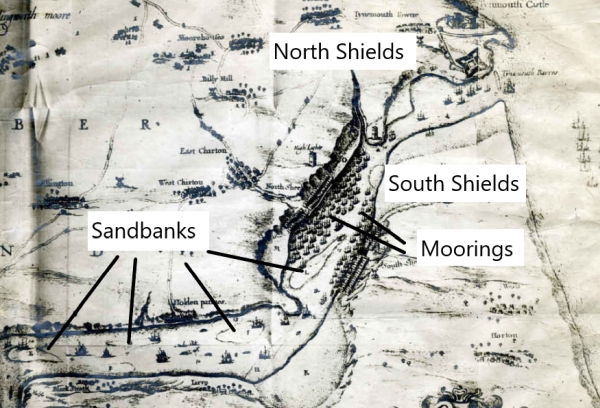
Entering the river was hazardous to vessels of all sizes particularly to seagoing sailing ships. On the south side of the river there was a large sandbank, the Herd Sands, that extended a significant distance from the shoreline that exists today. To the north there were two dangerous rocky shoreline areas – the Black Middens and Mussel Scarp. In addition, there was a shallow area of seabed across the river entrance known as the Bar. Seagoing ships, entering or departing the river, could only cross this obstacle at periods of favourable high tide. Between the Bar and the entrance to river vessels also needed to negotiate the confines of an area known as The Narrows – see Figure 2.
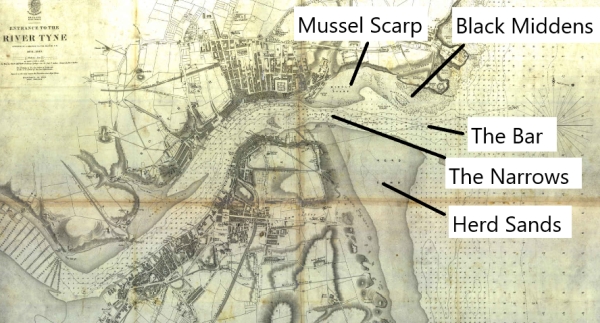
As well as the need to negotiate the natural hazards of the river entrance, the successful navigation of the sailing vessels into and out of the river, required favourable wind and weather conditions. Such conditions were not always available and, as a result, entering or departing the river was a particularly hazardous operation, taxing the capabilities of the most skilful of seafarers. Vessels frequently ran aground, often with tragic consequences for many seafarers, their dependents and their would-be rescuers (life brigade).
The growth of the manufacturing industries, that came about from the middle years of the 1800s, meant that development of the river was essential. It was also crucial that the entrance to the river was made as safe as possible and so the need for the Tyne Piers was established.
Management of the River Tyne
In the 1800s, the River Tyne was controlled by The Corporation of Newcastle (CON). Despite the vast majority of the commercial activity being concentrated at North and South Shields, CON received all of the income from port fees, taxes etc arising from the shipping activities on the river. It was CON’s responsibility to conserve the condition of the river and prevent it from deteriorating; an obligation that they singularly failed to fulfil.
In the 1840’s, CON’s control of the river was increasingly opposed by an ever more determined association formed by the shipowners of North and South Shields. The shipowners recognised the economic potential that could be achieved by improved management of the river. They proposed that this could be best achieved by the formation of an independent commission to manage and administer all maritime activities. An increasingly bitter confrontation ensued between CON, who wished to maintain the status quo, and the ship owners. Campaigning by both parties extended to representations being made to Parliament, including the introduction of bills to achieve their own individual objectives.
For many years the Royal Navy had an interest in the River Tyne. Historically, they had always prized the seafaring skills of the sailing fraternity of the area who crewed many of their ships; press ganging activities were often carried out on the river. In the 1800s they also recognised the shipbuilding and industrial potential of the river. With this interest in mind, they were concerned about the political confrontation between CON and the shipowners. So, in 1849, the Admiralty decided to carry out an inquiry into the state of the river and its management.
The Admiralty’s investigations found that CON had seriously neglected their responsibilities to maintain the river and had allowed its condition to significantly deteriorate. Surveys, carried out during the inquiry, found that CON’s failure to carry out monitoring and maintenance had caused extensive silting up and, as a result, significant deterioration of the navigation channel. Many of the quays along the river were also found to be unworkable. In addition they found that, of £960,000 worth of income generated from shipping over the preceding 42 years, only £40,000 had been spent on river improvements. The balance having been spent on the city of Newcastle.
The findings of the Admiralty paved the way for the change of management of the river and, in March 1850, Parliament found in favour of an elected commission. In July of that year royal assent was granted and so the Tyne Commissioners were formed (now The Port of Tyne).
The Construction of the Piers
The Tyne Commissioners held their first meeting in November 1850. One of their early considerations was the piers and how to proceed with their design and construction.
During the struggle to establish the formation of the Tyne Commissioners, designs for the piers had been provided by two well-known civil engineers of the day – J. M. Rendel and W.A. Brookes. Aspects of both designs were favoured by the Commissioners but, before they could be developed further, the Admiralty advised that they were unwilling to proceed with the works on that basis.
The Admiralty had previously successfully worked with the engineer James Walker, also a well-known civil engineer, on a significant number of maritime projects around the British Isles. Walker was also President of the Institution of Civil Engineers and clearly someone they had confidence in to deliver the project. To avoid any conflict and the consequences of further delay, the Commissioners agreed to accept the Admiralty’s preferred engineer and Walker was duly appointed to carry out the design and supervision of the project.
Despite Walker’s extensive experience he did have concerns about the difficulties that would need to be overcome in the construction of the piers. He made the following declaration:
“The sea is such a varying element in engineering calculation and varies so widely in its effects in different places that the people of Tyneside would have to gain their own experience and, when that has been gained, must be guided by it.”
This statement could be seen as somewhat faint-hearted and lacking in confidence. It should be remembered, however, that the design of this type of structure was in its infancy. It is likely that Walker was alerting the Commissioner’s to the likelihood that the final form of the structure could not be established at the start of the works. As events were turn out, his words would prove to be prophetic.
Walker’s arrangement for the piers was determined by the following key objectives: –
1 The provision of shelter to vessels entering and leaving the river.
2 The removal of The Bar.
3 The enclosure of as large a “spending” basin as possible. This would limit the action of waves entering the river.
4 The provision of an area if beached upon which the energy of the waves could be dissipated.
The proposed general arrangement to achieve these objectives is shown in Figure 3. Both piers, shown in this arrangement, consist of masonry superstructures founded on mounds of rubble stone placed on the seabed. The top surface of the mound being approximately one foot below low water spring tide.
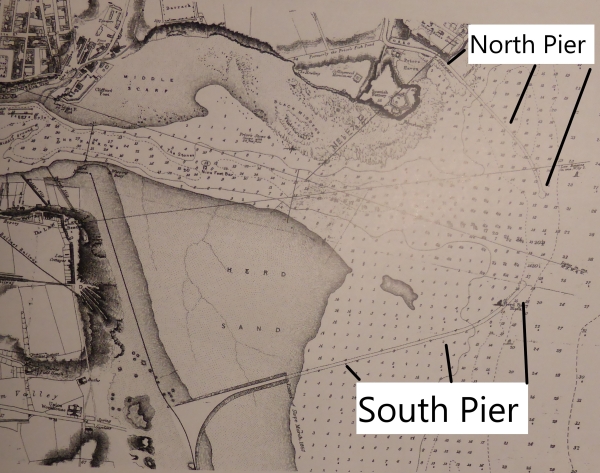
The original design cross-section of the North Pier, refer to Figure 4, was to be formed of two outer masonry walls built upon the rubble mound. Both walls of the pier being connected at regular intervals by masonry cross-walls. The space between the walls was infilled with loose quarry debris. In the case of the North Pier an upper promenade was provided on the seaward side with a lower inner promenade.
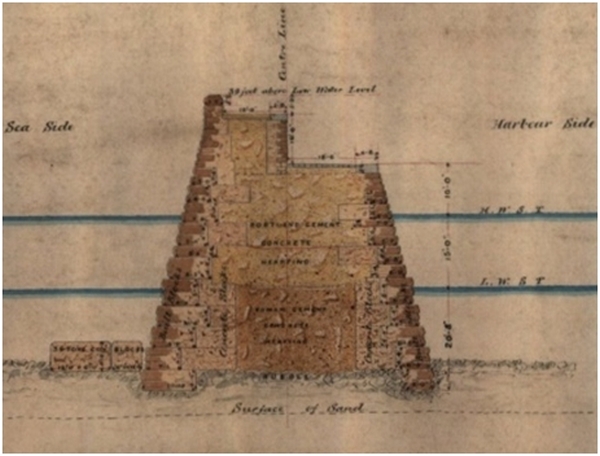
As shown on Figure 5 the landward end of the South Pier was also to be founded on a rubble mound. At the landward end of the pier the superstructure consisted of sloping seaward and inner masonry embankments with rubble infill. A single level promenade was also constructed. Towards the seaward end of the South Pier its structural form transitions to an arrangement similar to that shown for the North Pier.

Walker’s original design lengths of the North and South Piers were 2,100 feet and 4,200 feet respectively. A minimum dredged depth of 15 feet below low water spring tide was to be provided and the entrance width, at the extreme end of the piers, to be 1,100 feet.
At the request of the Admiralty, the Commissioners limited their financial commitment to 1,400 feet of the North Pier and 2,800 feet for the South Pier. Conceivably the reasons for the limited commitment were in recognition of Walker’s words of caution and the likely need to change the structural form of the piers as the works progressed and further construction experience was gained.
So, in June 1854, to great public fanfare and celebration, the foundation stone for the North Pier was ceremoniously laid – see Figure 6. Following the appointment of the contractor, Benjamin Lawton, the actual construction works on the North Pier, began in earnest in October 1855 with work on the South Pier starting in March 1856.
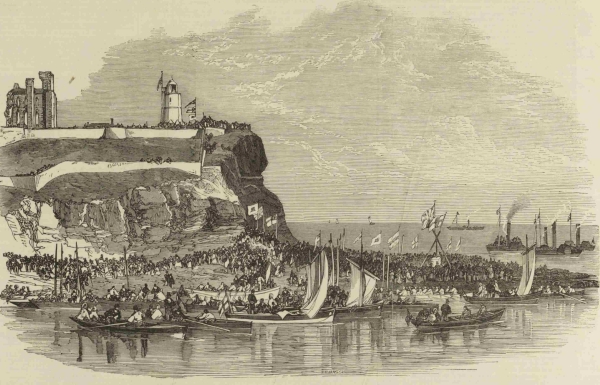
Overseeing many of the other major engineering activities, being carried out on the river, at the time was the engineer John Francis Ure. Ure was a renowned maritime civil engineer who had worked extensively on the River Clyde. Based on his experiences on the Clyde he had already prepared various reports for the Tyne Commissioners. These included the extensive works involved with dredging the river and the construction of various major engineering structures, including the Newcastle Swing Bridge. His role also included the initial supervision of the pier construction.
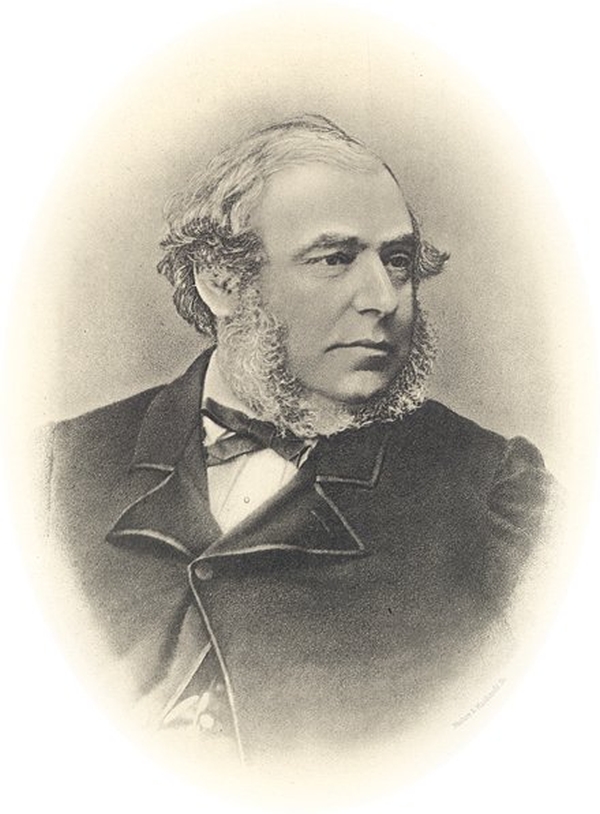
Notwithstanding Ure’s overall responsibilities, the engineer who was to have the most extensive daily input to the construction of both piers was Philip John Messent. He had previously been involved with the preparation of the original design of the piers in Walker’s London office. At the age of 25 he took up the position of Resident Engineer for the onsite supervision of the construction. A position, which he would not realise at the time, he would fulfil for the rest of his life.
It is possible that the Commissioners decision to limit their financial commitments to the piers was in recognition of the enormous changes in engineering practices that were taking place in this period. At the start of the construction of the piers, dredging of the river had started and the vessels trading with the river were gradually increasing in size. In addition, significant developments were also taking place in the shipbuilding industry and the shipyards of the Tyne were becoming world leaders in the design and construction of increasingly larger vessels. This is typified by the construction of the paddle steamer, the Connaught, at Palmers Shipyard in Jarrow. At its launch in April 1860, see Figure 7, this vessel would be the second largest afloat in the world. During the design period of the vessel a draught of 22 feet was proposed; clearly this did not suit the pier’s dredged depth of 15 feet that had been committed to by the Commissioners.

No doubt this must have been a period of compromise between the shipbuilders and the civil engineers requiring bold decision making by both. On the one hand shipbuilders were committing to increased draughts of ships whilst the pier designers had not established the feasibility of increasing the depth of the dredged channel or the size of the structures. To resolve this situation, Walker was commissioned to carry out a design study and subsequently proposed several options to the Commissioners. An arrangement providing a dredged depth of 30 feet was selected.
Walker’s proposed general arrangement for new design of the piers is shown in Figure 8. Whilst the options about the design depths were being developed the construction of the piers had continued. They had reached such lengths that, in order to maintain the required entrance width of 1,100, it was necessary to alter the direction of the piers. This resulted in the distinct outward sweep of the South Pier that we see today. The redesign also involved the use of significantly increased sizes of dressed stone foundation blocks, masonry faced concrete blocks and concrete fill.
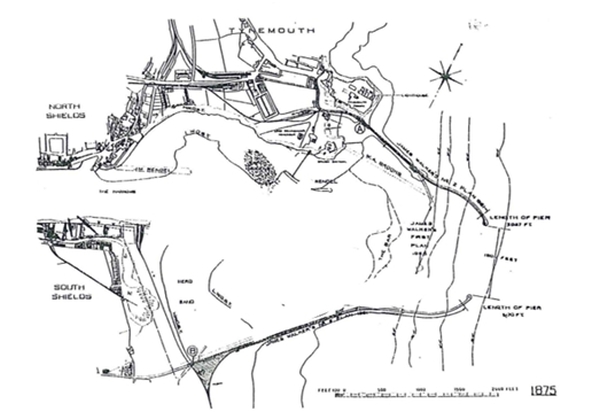
Construction Materials
Significant quantities of material for the piers came from the local Trow Quarry. Additional materials were also transported by rail from quarries at Benton, Byker, Whitehouse, Heddon, and as far afield as Cornwall.
The rubble mound, at the extreme landward end, of the South Pier was formed by tipping stone from Trow quarry, see Figure 9, directly onto the beach. The stone was transported in wagons, initially pulled by horse and subsequently steam locomotive, on a purpose-built rail system. Prepared magnesium limestone from Trow Quarry forming the surfaces of the embankments of the South Pier embankments were transported in the same manner.
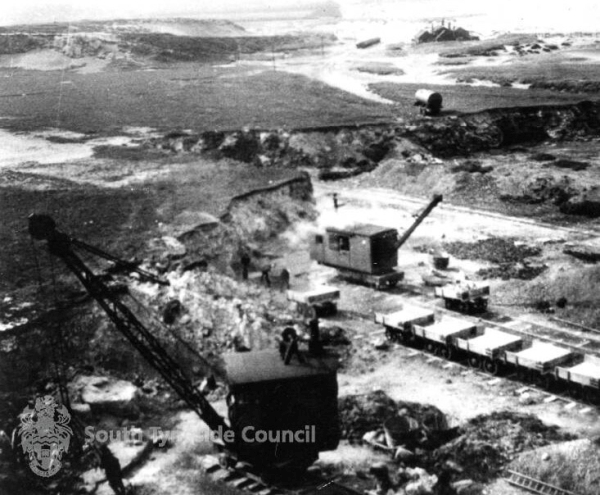
Stone for the North Pier was transported by railway wagon from Trow Quarry to a temporary timber riverside landing on the south side of the river.
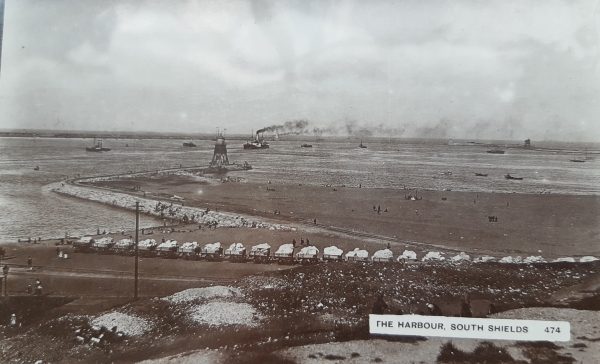
After being loaded onto barges the stone was then shipped to temporary timber landings on the north side of the river. – see Figure10.

Construction method
The rubble mounds, constructed in the tidal and intertidal areas, were formed from stone of varying sizes up to a maximum weight of approximately 3 tonnes. The stone was transported from the quarries to the riverside landings and loaded onto bottom and side opening barges. The barges were then towed into position by steam tugs and the stone offloaded onto the seabed. To allow for settlement of the seabed, the mound was placed well ahead of the construction of the pier superstructure.
The temporary works arrangement for the superstructure of both piers is illustrated on Figure 11. The staging, shown in the figure, was erected on the rubble mounds and used to lift into place the masonry blocks of the pier superstructure. Following the completion of a particular section of the superstructure the temporary works were dismantled and then re-erected to suit.

The construction sequence was as follows:
1. Form rubble mound by dropping stone onto seabed Erecting temporary staging including transverse and longitudinal structural members.
2. Install temporary rails tracks.
3. Erect goliath cranes.
4. Place foundations stones.
5. Construct the superstructure.
6. Dismantle temporary works.
A photograph of the temporary works for the pier is shown in Figure 12. In the foreground can be seen one of the diving bells that were used extensively in the project.
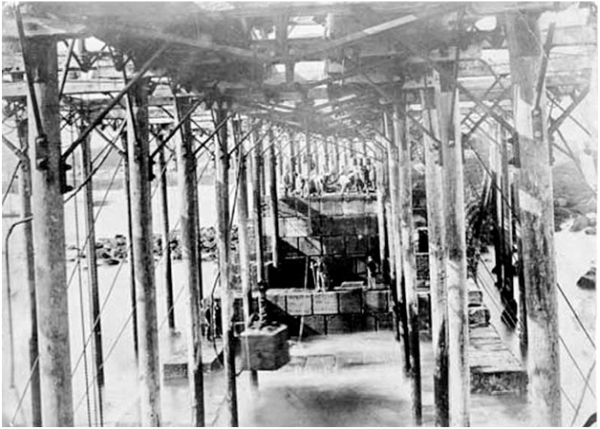
Construction Progress
During storms the staging suffered little damage but the goliath cranes were in, extreme conditions, washed overboard. Recovering and reinstallation the cranes, however, did not generally prove to be so difficult and they were quickly brought back into operation.
Whilst the piers were under construction the river remained operational. Vessels, entering and departing the river, continued to be vulnerable to storm conditions and during such conditions it was not unusual for ships to collide with the completed sections of the piers – see Figure 13. Records show that the staging, at the construction face of the piers, was also vulnerable to ship impact. On such occasions “disentangling” vessels from the staging could take several weeks with the consequential effect on progress of the works.

Work continued throughout the year. Unsurprisingly, the rate of progress during the summer months was significantly greater than that which could be achieved during the winter and the annual average rate of progress was approximately 300 feet per pier.
Damage to the completed parts of the work due to severe weather was common and undermining of the foundations often occurred. Significant storm damage occurred in the period between 1861 to 1865, which was repaired by a variety of techniques including using larger rubble stone, placing heavy iron chain in the infill between the masonry walls, deepening the foundations and bagged concrete (dry concrete mix in sacks) which was dropped or placed by divers around the base of the superstructure.
Further major storms occurred in 1867 resulting in the cranes being washed overboard and major collapse (hundreds of feet) of the pier walls. Repairs required further increase in the depth of the foundations and the use of larger foundation stones. These repairs took 7 years to complete. The works seemed to proceed in the above manner for the following years – the ends of the piers pushing relentlessly seaward and at the same time repairs of storm damage to the previously completed works being carried out. Nevertheless, up to 1879, 25 years after the start of the works, 2300ft. of North Pier had been completed (85% of the design length) with 4800ft. of South Pier completed (87% of the design length).
As the work front of the piers continued seawards, so it became increasingly exposed to the actions of the sea and weather. The construction problems were exacerbated as ever-increasing water depths were reached and by the increased exposure of the structure to the action of the sea. No doubt thoughts were given to options for increasing the rate of construction progress and Messent was the driving force in introducing two construction methods that achieved this objective.
Steam bucket dredgers: Up to 1877 the general method of levelling the rubble mound was to use divers operating from small craft or from the staging of the temporary works; a dangerous and time consuming activity.
Bucket dredgers, see Figure 14, had been operational in the river for some time and it was decided that they may be useful in the levelling of the rubble mound. Following their introduction it was found that during a few weeks of use they had been able to handle as much stone as the divers had in the previous two years.

Cranes: In 1879 Messent proposed the use of larger foundation blocks. In order to place these he was instrumental in the introduction to the project of a large rail mounted crane on both piers – see Figure 15.
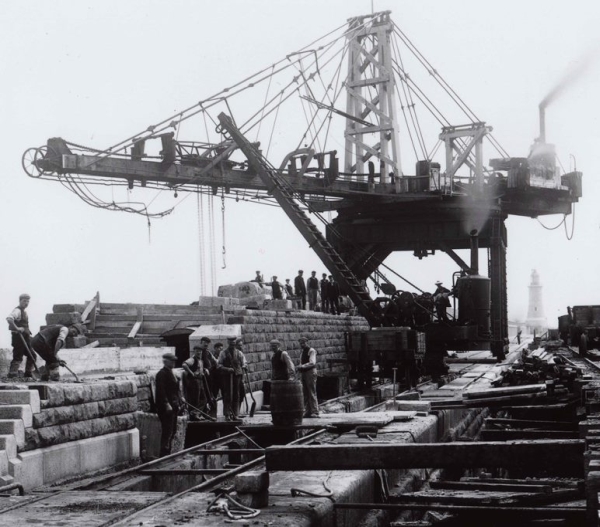
The cranes were procured from Stother and Pitt, a well-known crane manufacturer. They were of timber and iron construction and weighed approximately 330 ton. Their steam powered engines provided a lifting capacity of 45 tonnes at a hook radius of 92 ft. The cranes were the first of their type to slew through 360º. The North Pier crane was installed 1883 and the South Pier crane in 1885. They introduced greater flexibility, simplified the construction method and avoided the need for the temporary staging. Importantly they increased the rate of progress and, by December 1887, approximately 95% of the works had been complete.
Completion Works
At the end of 1887, work at the end of the piers, was suspended for a period of 15 weeks. The reason for this was that there had been many changes to the river and harbour since the start of construction. Extensive dredging of the river had been carried out and it was calculated that, at the eventual completion of the works, 13,000,000 cubic yards of additional tidal water would pass between the piers. Messent was concerned that by maintaining the originally intended entrance width of 1,100 feet, between the piers, that an unacceptable tidal speed would be created. Calculations concluded that the current, at the entrance, could be limited to acceptable levels by changing the opening width to 1,300 feet. Based on the revised opening widths the completed lengths of the piers were also established (North Pier 2,959 feet and South Pier 5,170 feet). Having set the target for the completion of the projects, no doubt all involved would be relieved to see the “end in sight”. As events were to turn out, however, many difficulties remained!!!
Work continued resolutely on the piers and eventually construction of the roundheads (ends of the piers) began. The effects of the sea and weather, however, continued to impact the project and, in November 1893, shortly before the roundheads were completed, the much-valued crane of the North Pier was washed overboard. Following significant efforts by the divers, the crane was recovered and returned to service to complete the roundheads and to carry out the construction of the lighthouse. About a year later the crane of the South Pier was also washed overboard and, although partly recovered by the divers, it was not brought back into service. Despite these setbacks, work continued and in late 1895 the lighthouses of both piers were completed.
Having reached the end of the designed lengths of the structures and completing the erection and commissioning of the lighthouses Messent, with trepidation, announced the completion of the piers. Any thoughts of grand celebration seem to have been somewhat restrained; although they had reached the physical end of the piers, they perhaps feared that they had not reached the end of the works.
North Pier Construction Problems
The reason for Messent’s anxiety was that underwater surveys, carried out following the storms of 1893 (loss of North Pier crane), had identified that extensive undermining of the foundations had occurred. Repairs had been carried out at the time but there were concerns about their effectiveness and the continued scouring action of the sea; further loss of the foundations and undermining was feared.
In the spring of 1896, following further surveys by the divers, considerable lengths of the foundations were found to have been undermined. Repairs were carried out but, due to the exposed location of the work area, it was difficult to safely gain access. To protect the divers and workforce, the Commissioners went to the extent of sinking a 220-foot-long ship (S.S. Roxana) alongside the north face of the North Pier. The ends of the vessel were sealed off against the piers by concrete blocks to form a cofferdam (a watertight enclosure) providing thereby a sheltered area for the workforce.
Despite the efforts of the workforce, significant structural failure of the North Pier occurred. It must have been a “jaw dropping moment” on January 23rd, 1897, when the workforce arrived on site to find that more than 100 feet of the seaward wall had fallen outwards creating a complete breach of the structure. Due to the continuous action of the sea, on the exposed core of the pier, further damaged was inevitable resulting in the eventual loss of almost 300 feet of the structure see Figures 16 and 17.
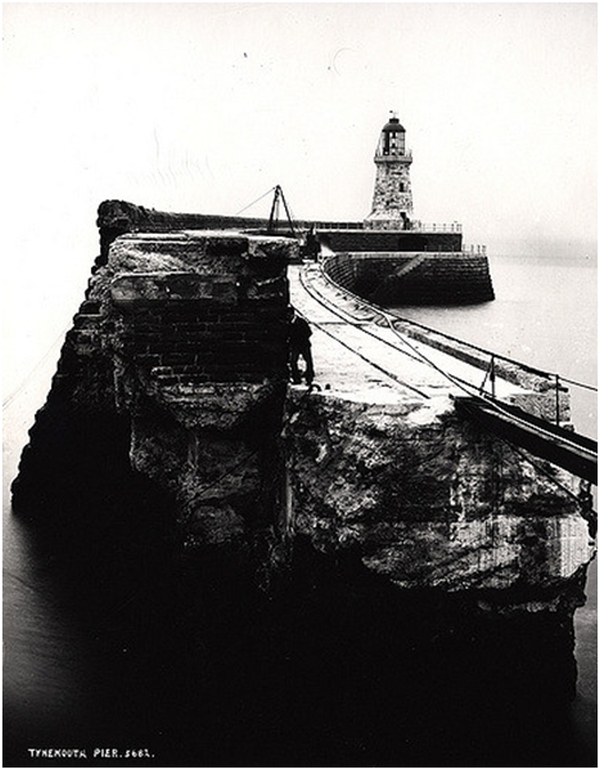
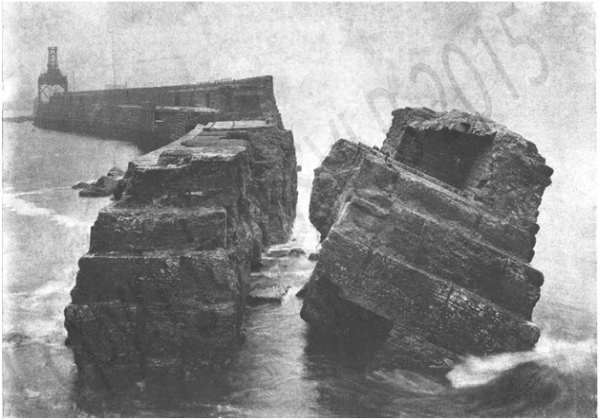
At the time of the breach of the North Pier, Messent’s health was in decline. Concerns over the dramatic failure of the North Pier are likely to have impacted on his wellbeing and in April of 1886, at the age of 66 years, he died. Up to his death he has been working on a solution to the problems that had been encountered, many of which were made use of in the following years
Messent’s work was developed further by a firm of consultants (Sir John Wolfe Barry) who had previously worked on various projects for the Commissioners. A proposal involving realignment of the seaward end of North Pier was selected – see Figures 18. The reconstructed works made use of interconnected concrete blocks, of various sizes up to approximately 30 ton creating a significantly more robust structure – see Figure 19.

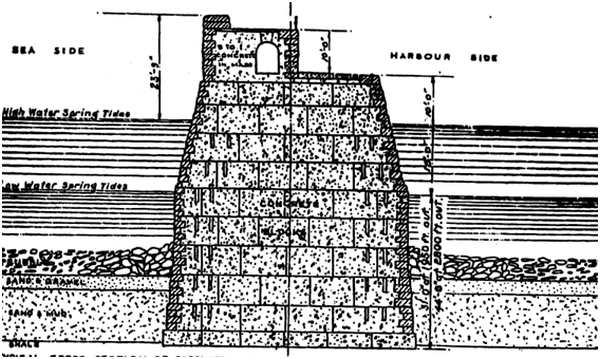
The increased block size required the used of significantly greater temporary works and the reconstruction work, including the new lighthouse, was not completed until 1909.
South Pier Construction Problems
The goliath crane, washed overboard in 1894 from the South Pier, was not considered to be required for the completion of the works and it was not replaced. Work continued on the pier and the storms, that wrought so much havoc on the North Pier in 1896, did not seem to have caused any significant damage to the South Pier. Minor works were ongoing but it was generally considered that the works on the pier were nearing completion. In 1898, however, a severe storm occurred causing significant undermining of the seaward side of the pier near to the roundhead. Bearing in mind the failures that had occurred due to undermining of the North Pier, this situation must have been viewed as alarming. Without a crane of sufficient capacity to carry out repairs there were, no doubt, major concerns about further destabilising of the foundations and possible collapse of the structure.
Fortunately, the Commissioners, with the assistance of Stother and Pitt (Crane suppliers), were able to acquire a large dockside crane, commonly known as the Titan crane. This crane had originally been intended for the Admiralty’s naval dockyard in Gibraltar. Fortuitously it was surplus to the Admiralty’s requirements and became available to work on the pier. After transportation and modification of the legs of the supporting structure of the crane, it was erected onto purpose-built rail tracks on the South Pier – see Figures 20 and 21. Following load testing, it became operational in June 1899. After being used to infill undermined areas of scouring with mass concrete the crane was used to lift a large number of 41-ton concrete blocks. These were placed in front of the damaged seaward face of the pier. In 1909 further repairs were required in the area and an additional concrete wall was also constructed on the extreme seaward end of the concrete blocks.
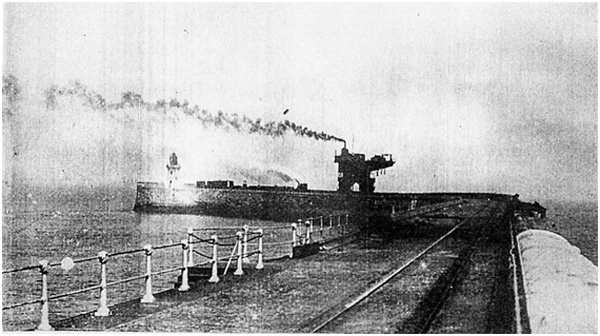

The works on the South Pier were finally completed in 1915. The Titan crane remained operational to carry out ongoing maintenance works and was decommissioned in 1987.
Heroes
Technically, the piers are known as breakwaters; they provide shelter from the actions of the sea. Actions that, on the northeast coast of England, can frequently be severe and dangerous. It was against these conditions that the labour force had to work and continuously advance, in a seaward direction, the construction front of the piers.
At the start of the project the construction work front of the piers was close to the original coastline but as progress was made it was continuously moving into deeper and increasingly hostile waters; in the case of the South Pier eventually by almost 1 mile. At times it must have taken a large measure of courage for the workers – see Figure 22 to daily “slog” along the completed sections to the ends of the piers where the ongoing construction activities were taking place.

Once the work front was reached hazards were ever present; the working conditions of the 1800s were, no doubt, incomparable to modern day health and safety standards. Indeed, editions of the North and South Shields Gazette frequently described accidents that had occurred on the piers, a typical example of which is shown in Figure 23.
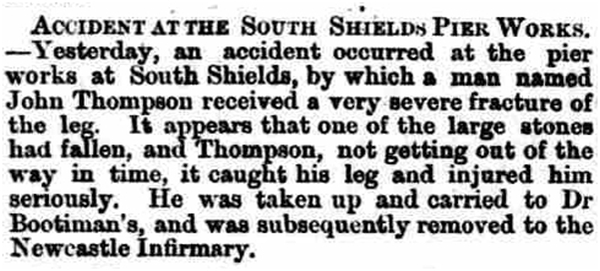
During the construction of the piers many risky activities were carried out by all members of the workforce; perhaps none more so than the helmet divers – see Figure 24. Until the later introduction of the steam dredgers the divers were involved in manhandling and levelling the rubble mound. They were also responsible for lowering, aligning and installing all of the foundations and the lower levels of the masonry walls of the piers. Operating from jib mounted small craft and from the construction cranes of the piers they were often in dangerous situations.
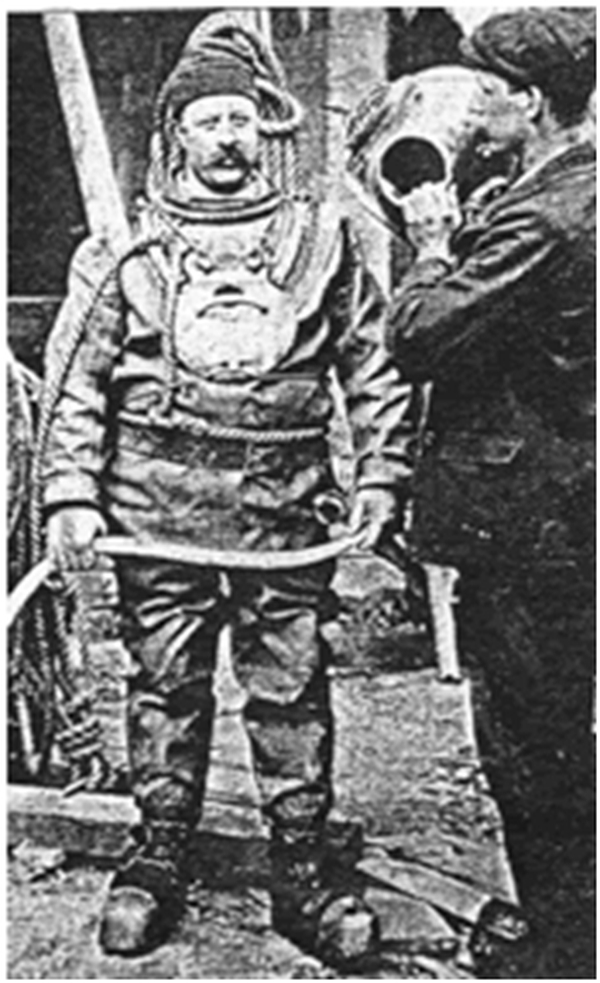
All major projects require leaders and Messent fulfilled this role on the piers for virtually all his working life. Walker recognised that the structural form of the piers would need to change as construction experience was gained. Messent seems to have been the ideal candidate to adapt the design of the piers as they progressed into unknown ground conditions and aggressive environment. As well as his daily leadership of the project he was also responsible for introducing the steam dredgers and the large cranes that would become so effective in accelerating the construction progress. Large quantities of concrete were required for the works and Messent was also responsible for the design and introduction of a mobile rail mounted mixer – see Figure 25; the forerunner of the concrete wagons that we see on today’s roads.

On the lighthouse of the North Pier there is a dedication to the engineers and senior managers involved with the project – see Figure 26. Unfortunately, there is no mention of the work force on whom the project relied. Their contribution to the successful outcome of the project should, however, not be unrecognised or overlooked.
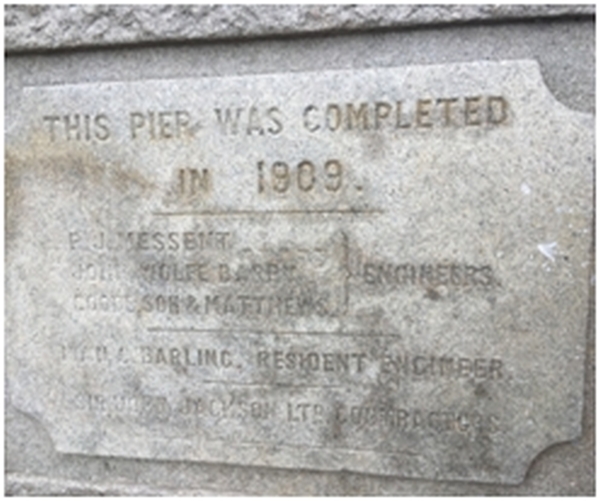
Conclusion
The construction of the Tyne Piers has been recorded as one of the most difficult undertakings of its kind ever carried out in this country. The works involved a relentless construction battle of 54years and the piers stand in testament to the resilience, bravery and commitment of our forebears.
Without the piers, the mouth of the river would have been unprotected. All industries (shipbuilding, ship repair, manufacturing, coal export and trade) relying on the river, would have been adversely affected; perhaps they would not have existed at all. The social and economic effects on a Tyneside without the piers are unfathomable.
In short, the North and South piers are magnificent structures that all Shields folk should be proud of. Who knows where we would be without them?
Sources:
Written by Ian Hudson
On Friday 20th October 2023 storm Babet tore the dome off the end of the pier.

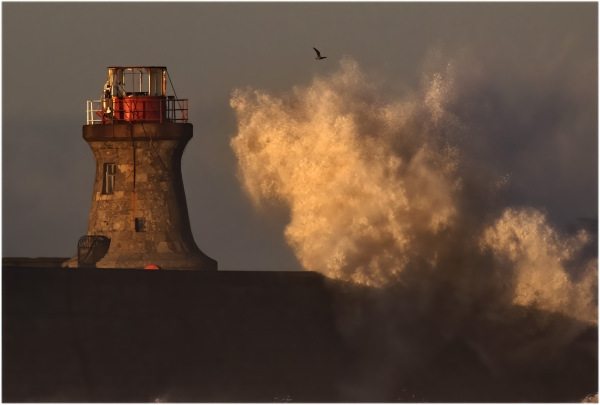
Photos:
British Newspaper Archives
Ian Hudson
Pete Hampson
John Short
South Shields Volunteer Life Brigade
South Tyneside Libraries
Tanfield Railway
